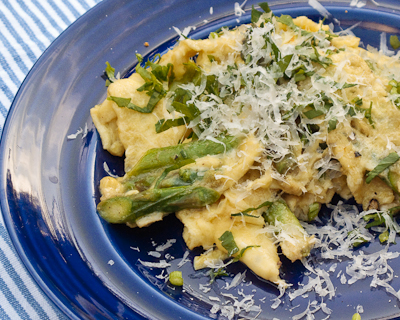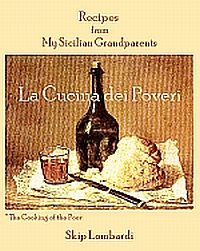The New Portuguese Table
May 9th, 2010When I lived in Portugal, it was not yet a member of the European Union. USAID still had a Lisbon office because, even in the 1980’s, Portugal’s economic development lagged far behind the rest of Western Europe and the nation met criteria for American aid.
Despite decades of northern European and British tourists seeking sun of the shores of the Algarve province, Portugal’s cooking was conservative, and I mean that in a positive way.
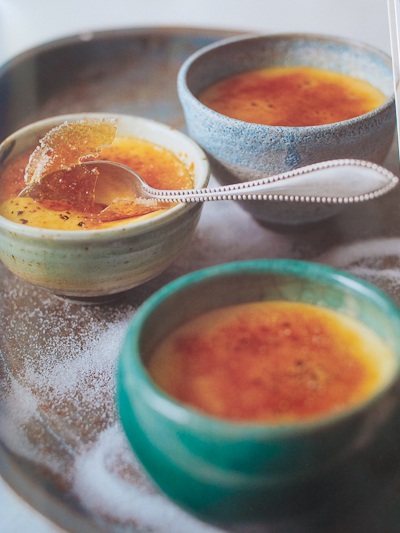
Photo Credit: Nuno Correia from The New Portuguese Table
Cooks were fiercely self-confident and their dishes regionally distinct. The country’s legions of farmers and shepherds as well as its coastal Atlantic fishing fleet made most Portuguese locavores by default. The words “nouvelle cuisine” had not yet been whispered in Lisbon, where culinary fusion (circa 1985) meant that medieval Moorish recipes for marzipan and candied egg yolks might incorporate chocolate from Portugal’s former colonial plantations in Brazil or Angola. French influence was present, but only in the kitchens of the old aristocracy or chandeliered restaurants where London wine importers lunched with Lisbon bankers. Techniques and sauces of the ancien regime français had arrived with bayonets, when Napoleon’s armies overran the vineyards and groves of olives, citrus, and stone fruits surrounding Portugal’s quintas, the grand country estates.
But like David Leite, whose southern New England turf I’ve shared, I first knew a very different kind of Portuguese culinary world, that of the Portuguese-American diaspora, largely from the Azores, Portugal’s mid-Atlantic islands. Azorean mariners had settled amongst earlier immigrants—the Germans, Irish, Italians, and Slavs of New England ports and mill towns. They founded their largest enclaves in Massachusetts and Rhode Island and their struggles and success, like those of all new American immigrants, would be reflected in the food and drink of celebration, homesickness, and consolation.
It was a world of boisterous relatives crowded into kitchens that the adolescent David Leite, wishing to be reborn as a WASP, tried to escape. Fortunately maturity and the flood of culinary nostalgia that can overtake us as we contemplate the inevitable loss of beloved elders pushed him to reexamine his cultural identity. He set about to gather recipes from his mother and grandmother.
Then Mr. Leite embarked, not just for the Azores (his parents’ birthplace), but also for Iberian Portugal, to discover that the 1950’s Kodachrome postcard-views, his family’s recollections, had faded. By the 1990’s, Portugal, that once-charming backwater, had become a full-fledged member of the European Community. As Mr. Leite dined with urbane friends immersed in the sophisticated and rapidly changing gastronomic offerings of Lisbon, he was astute enough to realize that he must “embrace this meal, this dining scene, this Portugal.” More importantly, he recognized that, in doing so, he was not “betraying” his family.
Most of the recipes of The New Portuguese Table have antecedents in typical Portuguese home-cooking, but Mr. Leite may use duck breast (rather than the whole bird) or give instructions to braise, rather than to fry in lard. He gives the nod to modern equipment like immersion blenders. Portugal’s cooks at both the home and restaurant levels are reaching into the global pantry and embracing more culinary influences from Portugal’s former colonies in Africa and Asia. Ingredients like fresh ginger, bird’s-eye chilies, and star anise show up frequently.
Frango Naufragado, Shipwrecked Chicken, is a vagabond that supposedly made its way from Mozambique to Chinese Macau via Goa before showing up in Portugal. Whatever the back-story, it’s delicious: grilled chicken meets coconut milk tomato paste, lemons, and chives. Fusion is now the operative word.
Mr. Leite gives us some real curiosities, including an old recipe for Licor de Leite. The liqueur may have a dual heritage in both the distillation techniques perfected by teatotalling Arabs and in the infused digestives concocted by cloistered Catholic orders.
But for those who simply want to recreate flavors from a honeymoon trip to Faro, Cascais, or Nantucket—Mr. Leite has some old favorites like Caldo Verde (Kale Soup) and Lulas Recheadas (Stuffed Squid). Meanwhile, he and his collaborators have created new dishes with staple ingredients—chouriço bread, fava bean salad, cilantro pesto, crème brulée infused with rosemary, and what can be legitimately described as a salt-cod slider or bacalhau burger.
The author acknowledges that “dishes… put in front of me by the women who love me” are the true foundations of the book. David Leite honors those old ways as he gives his readers new ways to capture and enjoy the distinctive flavors of classic and modern Portuguese cooking.
The New Portuguese Table is embellished with the work of photographer Nuno Correia and a team of food stylists and prop finders. Their efforts exemplify fine cookbook illustration and perfectly express the essence of Portuguese food.
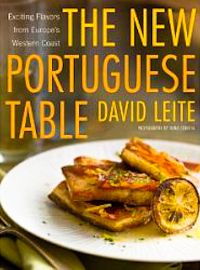
The New Portuguese Table:
Exciting Flavors from Europe’s Western Coast
David Leite
Clarkson Potter (August 18, 2009); 256 pages; $32.50
Cookbook Review: Steamy Kitchen
April 29th, 2010A few weeks ago, we asked the question: Do Cookbooks Matter?
To some of us—cooks, culinary writers, photographers, food stylists, graphic designers, publishers—these books are part of our livelihood. To the vast number of people who dream of wearing one of those food-career labels, cookbooks are escapes from a world in which meals are mostly grabbed on the run by those who too rarely participate in either cooking or dining with others.
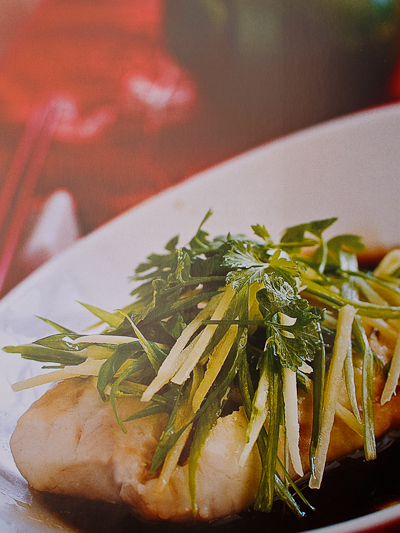
Mom’s Chinese Steamed Fish from The Steamy Kitchen Cookbook
Photo by Jaden Hair
We’d contend that viewers watch Food TV more to be with entertaining “food people” than they do to learn how Paula Deen mixes meatloaf or Ina Garten whips cream. Whether pictures of the geeky Lee Brothers and their friends cracking crabs at a Low Country picnic are in a book or a magazine, to see the photos invites us to suspend reality and to temporarily share that camaraderie—even if all we are contemplating for a solo dinner is diet soda and half a cup of cottage cheese .
When it comes to cookbooks, picture-perfect presentations of artisan loaves, rustic faience platters beneath glazed roasts, exotic table textiles, candles, and wildflower bouquets (all expertly captured by the camera) are part of the allure. But in the age of Facebook and “friends” one may never meet—it’s often the images of people, guests enjoying themselves around food celebrities, that allow us to share the hipness and happiness so much harder to achieve in our real lives.
And while millions of these photos (not to mention thousands of cooking videos) can be seen on the Internet, cookbooks remain a way to remove ourselves from the world-view filtered by search engines. For better or worse, screen-delivered content is part of our lives. Whether we are lucky enough to still claim a job in a cubicle or are stuck at home, spending hours on Monster.com searching for jobs that would land us back in a cubicle, a lot of us live online. That’s one reason it’s soothing to read something on that material created by the ancient Egyptians—paper.
Continuing to examine and cook from the new books piled high in our dining room, today we look at someone whose trajectory we’ve been following for a few years:
Jaden Hair began Steamy Kitchen as a blog and expanded it into a successful cookbook that is testimony to both the realities of everyday life and the social rewards of sharing food. Chinese-American and raised by a mother who cooked, the author didn’t learn her craft at her mother’s wok, but fired up her own only when she became a homemaker and mother of two boys.
In brief—although a few of her offerings are classic Chinese (Mom’s Chinese Steamed Fish), most of Steamy Kitchen’s recipes are what we’d call fusion food or “Asian Modern” (Furikake French Fries, Pork & Mango Potstickers, Thai-style Chicken Flatbread, Asian Pear Frozen Yogurt). Jaden uses straightforward techniques, fresh ingredients, and some Asian pantry staples to yield brightly flavored dishes. Her stance is that authentic tastes and textures of Chinese, Thai, Vietnamese, Korean, Malaysian, and Japanese food can be readily achieved by home cooks willing to invest a little time and thought in a week-night family dinner.
Clearly, the Steamy Kitchen blog readers, scores of whom volunteered to test recipes for the cookbook, find food conversation stimulating; it adds another dimension to their social networking. Jaden-the-blogger has made her readers feel like friends around the table and has built an enormous following thanks to her seductive photography and casual, let-me-tell-you-a-secret monologue. Her telegenic appearance and personality haven’t hurt, either. But most significantly, Jaden’s recipes are for dishes readers want to make and share.
Jaden’s got it right—if you’ve read the recipe, assembled your mise en place, and follow her instructions—it won’t take much time to prepare a delicious meal, one that will surpass anything you could order in most Asian restaurants in America.
The most striking aspect of The Steamy Kitchen Cookbook is the spectacular food photography. Self-taught and dauntless, Jaden-the-photographer managed to persuade Tuttle, her publisher, to let her do almost all the photography for the book. Given how far Tuttle went to feature a color picture of every dish, some bigger than life-size, one wonders why the handful of instructional photos (not taken by the author) weren’t given a little more space.
As one reader described it, Steamy Kitchen is “text-dense.” In addition to recipes, the book is packed with anecdotes, family memories, and copious credits to friends and fellow-foodies. What should not have been given so much real estate is the sophomoric, bloggy chatter, some of it trite and off-color. It’s a glaring distraction from the simple elegance of the recipes and illustrations. For their own sake and that of a first-time author, we wish Tuttle’s editors had asserted themselves at least as much as Jaden’s garlicky Asian Pesto.
Nonetheless, Jaden’s suggestion of using a Microplane to grate those devilishly hard lemongrass stalks gains her redemption. The text can be cleaned up for the second edition. For now, we’ll forgive her and wish her the success she deserves.
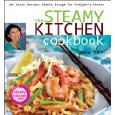
The Steamy Kitchen Cookbook:
101 Asian Recipes Simple Enough for Tonight’s Dinner
Jaden Hair
Tuttle Publishing (October 10, 2009); 160 pages; $27.95
On Guidebooks…
March 25th, 2010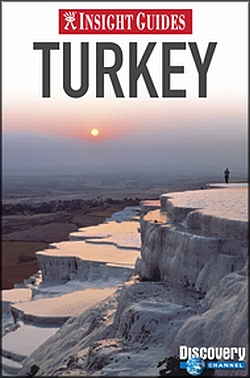
As a travel consultant specializing in the Mediterranean and the Middle East (I’ve lived and travelled extensively throughout those regions), I always urge my clients to read about a place before they make any reservations. I regularly compile both general and special-interest reading lists, making suggestions for travellers who may have a month to backpack through the Pontic Mountains of the Black Sea coast or merely an afternoon to escape their cruise-ship’s shore-excursion to Ephesus.
I have clients who ask for no more than clean youth hostels and overnight buses and many others for whom a 150-foot private yacht and a Lear-jet are barely adequate. Even after three decades of travel experience, I still have to do my homework to keep up with what my clients want—or think they want—based on what they’ve seen, read, or heard before they come to me.
In some ways, it’s more work than ever. Now, in addition to doing my own research in situ, I have to know what Rick Steeves, Conde Nast, Fodor, Frommer, The New York Times, Travel & Leisure, and assorted Websites are saying. So, I read a lot of prosaic, and sometimes silly, articles that were cut and pasted from PR materials supplied to travel-writers on fam trips. And knowing my clients won’t be able to read a Google map of the ancient city of Pergamum on an iPhone when it’s high-noon, without a shade-tree in sight, I review guidebooks.

Archeological site of Pergamum
That’s right, I still value those relics of alternative information technology: hand-held, dead-tree devices containing static data on analog pages. Many of my favorites are not in English; others are long out-of-print, and that may be just as well, because their irreplaceability makes them too valuable for me to be tempted to pack them in this age of luggage minimalism.
For years, I’ve been a fan of the INSIGHT GUIDES series—using their stunningly illustrated (and consequently hefty) volumes to help plan my own travel. Whether using them in my long-time stomping grounds in Turkey, Greece, Syria, and Jordan or for lands beyond (South America and East Africa), I have always found that their cogent text and photos compelled me to want to learn more, as both a reader and a traveller. And in this Internet era, I think that’s what guidebooks SHOULD do.
Recommendations of hotels and restaurants, closing times, train schedules, and fare prices, change too rapidly to be well-documented in books. These days, that information is best found online and confirmed, as needed, by email, a phone call, or fax. With Internet cafes and Wi-Fi access so widespread, much of what guidebooks once contained need not be committed to printed pages. If you want extensive lists, with stars and prices to rate hotels and restaurants, Fodor and Frommer will oblige you. But if you’d prefer pithy commentary on the Kurdish-Turkish dispute, the politics of urban building, ancient mythology, Byzantine gossip, and opinionated travel recommendations (“The road south leads to Hakkari, a town best avoided…“), Insight Guides: Turkey will not disappoint.
The hundreds of color photos, larger type, and attractive lay-out on coated stock mean that Turkey weighs about two pounds. Both to pack and also to lug Turkey along as one negotiates the cobbled alleys of Istanbul, requires a real commitment from its owner. However, those winning photos are worth many times the weight, for they do speak volumes. So rather than criticize the series for being too fat, I would say that I unflinchingly recommend the books for planning your travels. But for most people, who want to travel light, the guides are best left home or at least back in your lodgings. Pocket guides they are NOT!
Insight Guides were first developed to serve adventurous European and British travellers, so they cover some terrain that may surprise Americans. The guides range from individual countries (Cuba, Malta, Namibia, Burma…) and a few states (Colorado, Florida, Texas…), to regions (Tuscany, Oman & the UAE, the American Southwest, the Turkish Coast…), and cities (Istanbul, Oxford, Kuala Lumpur, Perth…). There are also a handful of idiosyncratic guides to Amazonian and Indian wildlife and marine life in the South China Sea.
Insight also produces the Fleximap™ a laminated, folded city map. As an example, ISTANBUL includes a decent street index, detailed mini-maps of popular tourist areas, 26 short descriptions of major sites, and panels of emergency phone numbers with very basic notes on opening/closing hours, currency, and transportation. Tough enough to withstand a spilled glass of Turkish tea and fingers sticky from baklava, the map this would be perfect for the cruise passenger docked for two days in Istanbul.
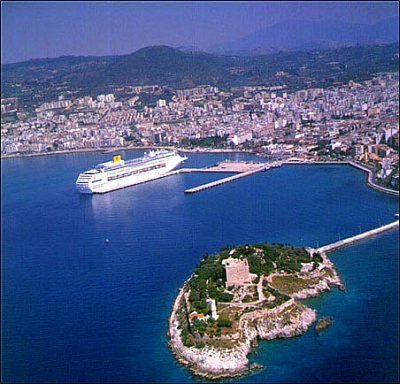
Cruise ship docked in Kusadasi, the Turkish port for Ephesus
But suppose you’ll be touring one or more countries on your own for a couple of weeks? You don’t want to pack a library, but you do want more than a map to read when you’ve missed your Greek island ferry and need to plan the next sixteen hours. If I were to chose ONE series for on-the-spot utility, I would select the narrow-format green Michelin guides—not as light as they once were, but still portable and packed with intelligent, entertaining writing on history and sights. Still in evidence are those convenient stars of recommendation. In the old days, when the guides were only in French, we also had those stock phrases mérite un détour and vaut le voyage .) As before, the Michelin guides include annotated lodging and dining selections and excellent maps that anticipate the user’s needs. (The Athens metro plan notes stations as they are actually signed, in Greek, along with English phonetic spellings.)
For further utility, the latest green Michelins include Web addresses, making them truly helpful planning companions. Unfortunately, Michelin doesn’t cover nearly as many regions as the Insight series (You’ll get Thailand, British Columbia, Lauguedoc-Rousillon and Greece, but no Turkey.)
So, if you are “planning to plan” a trip, go to the library or a a real bookstore to actually see (and lift) a few books in the series mentioned. And to get a dizzying view of the coverage available from just ONE publisher-distributor, go to Langenscheidt.com. I knew them first for their language-learning series, and I still have my yellow plastic-covered pocket Turkish dictionary from the 1970’s. This German publishing conglomerate now handles both the Insight and Michelin guides, along with the Berlitz and Langenscheidt dictionaries, phrasebooks, and CDs. Langenscheidt is also distributing an interesting series of cookbooks, but we’ll save our take on those for a future post.
Do Cookbooks Matter?
March 8th, 2010We write a lot about food. Our interests in history, gardening, and cooking inform our enjoyment of food and reinforce our belief that understanding culinary culture is vital to maintaining a civilized world.
All this has us thinking about the ways in which people share their gastronomic enthusiasms. Beyond growing, preparing, and consuming food together, people want to share ideas about food—even if they themselves may never serve or even taste the food they discuss. The best illustrations of this truism are the recipe-laden food blogs—and reader comments:
Delish!
Best ever, thanks for sharing.
I’m putting off my diet for this one, LOL
Must try, ‘cuz my hubby LOOOVES marshmallows.
OMG—this is awesome.
Anyone got a recipe for a good tomato sauce?
A keeper for sure!
As food bloggers, we’ve learned that only a small percentage of readers (ours or anyone else’s) will ever make any of the hundreds of thousands recipes to be found, free-of-charge, on the Internet or in the volumes filling miles of public library shelves.
But that does not prevent enthusiasts from prowling the aisles of independent and mega-chain bookstores that allow browsing at will and even provide tables and comfortable chairs to those they hope may actually buy books if given a chance to sit down with them. Last week we witnessed a 70-ish woman in the café of our local Barnes & Noble. Beside her, we counted a stack of of eight new cookbooks from which she was selecting recipes that she then copied in long-hand on a yellow legal pad. It didn’t appear she’d bought so much as a bagel or the café du jour, but she sat there for at least 90 minutes, deep in her research. We hasten to add that she was well-dressed and wearing a pair of sneakers that would sell for close to $150. (One of us is Italian and always zeroes in on shoes.)
Setting aside that copyist’s unabashed sense of entitlement, we’re still not sure what our sighting reflected or portends. Was it a good or a bad sign for those who write, publish and try to SELL words good enough to eat?
The magazine Gourmet is lying in state; many major American newspapers are on IV’s as feature writers, reviewers, and food editors lose their jobs. But recipes and food-focused articles continue to appear in many other publications on health, cooking, travel, and decor. Sit in the waiting room of your accountant, Toyota dealer, or daughter’s orthodontist; whether you pick up a six-month-old copy of Southern Living, the latest AARP Magazine, or a newsletter from an insurance company, you’re rarely more than a page away from a recipe accompanied by a photograph or article on comfort food; exotic ingredients; anti-oxidant vegetables; low-sodium or ethnic twists on old favorites; fusion, healthy-fast, or slow food; low-calorie, vegan versions of ethnic favorites… You get the drift.
This glut is an indication of Americans’ fascination with novelty and current fixation on “free” food (as in free of—guilt, salt, fat, gluten, cruelty, dairy, carbs, sugar, peanuts, pesticides, genetically modified ingredients, or red meat). Yet even with food everywhere we look, these are days of food exclusion. In our neighborhood, we’re hard-pressed to gather half a dozen friends who can share the same meal with omnivores like us.
And, despite an avalanche of free recipes and the worst economy many of us have ever known, writers and publishers are still bringing out new cookbooks. And people are still buying them.
We’ve asked ourselves and our friends why anyone still purchases a cookbook when it’s so easy to go online and come up with 45 Pad Thai, Pot Roast, or Paella recipes in less time than it takes to open a bottle of wine.
We’re collectors ourselves and have been at this a while. Thus, we weren’t surprised by the answers we got, which confirmed that many of the most avid cookbook accumulators never make more than one or two recipes, even from a book they love.
So what forces are sustaining cookbook publishing?
In the coming days, we’ll be trying to answer that as we review some new titles on the Sarasota Soundings blog.
And we’d like your contributions, too. Tell us why you and those in your own circles buy cookbooks or like to receive them as gifts. If you want to cite a favorite (and agree to eschew words like “delish” and “awesome”) we’d welcome a couple of lines telling us why a particular book speaks to you.

Photo Courtesy Austin Evan
In the meantime, stay tuned for our take on several pounds of books on traditional and revamped food from Portugal to Korea…
